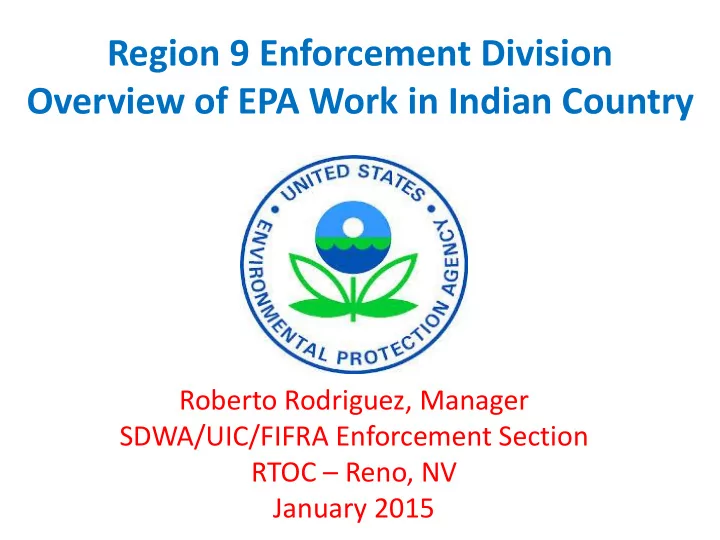

Region 9 Enforcement Division Overview of EPA Work in Indian Country Roberto Rodriguez, Manager SDWA/UIC/FIFRA Enforcement Section RTOC – Reno, NV January 2015
Enforcement Division Programs • Inspections, enforcement, and oversight of all federal statutes and primacy programs (few exceptions) • Environmental Justice Coordination • National Environmental Review Act Program
Air/TRI Enforcement • CAA - stationary source permits (Title V) Focus: Majors Sources • NESHAP/AHERA (Asbestos) • TRI – Ensuring facilities are reporting 1/30/2015 U.S. Environmental Protection Agency 3
Waste and Chemical Enforcement • Hazardous Waste Universe: TSDFs = 1, Large Quantity Generators = 24 • UST: Operating facilities = 192 • PCBs 1/30/2015 U.S. Environmental Protection Agency 4
Clean Water Act Enforcement NPDES Permitted Dischargers: • 39 domestic WWTPs (Tribes and BIA) • 13 industrial dischargers (mines, etc.) • Storm Water (construction & industrial) Current Priorities: • Inspections • Compliance Assistance • Significant Noncompliance (chronic discharge violations) • Complaints and Requests for Assistance • Consultation with Tribal Governments 1/30/2015 U.S. Environmental Protection Agency 5
Clean Water Act Enforcement (Cont.) Observed Problems: • Chronic discharge violations at WWTPs • Training and O&M needs • Aging infrastructure and poorly designed WWTPs
EPA’s 1984 Indian Policy • “In carrying out our responsibilities on Indian reservations, the fundamental objective of the Environmental Protection Agency is to protect human health and the environment.” • “The Agency will strive to assure compliance with environmental statutes and regulations on Indian reservations.” 7 7
1984 Indian Policy & Enforcement • “EPA will work cooperatively with Tribal leadership to develop means to achieve compliance, providing technical support and consultation as necessary to enable tribal facilities to comply.” 8 8
1984 Indian Policy & Enforcement (continued) Because of the distinct status of Indian tribes and the complex legal issues involved, administrative or judicial enforcement to address noncompliance at facilities owned or managed by tribal governments will be considered where the Agency determines, in its judgment, that: (1) a significant threat to human health or the environment exists, (2) such action would reasonably be expected to achieve effective results in a timely manner, and (3) the federal government cannot utilize other alternatives to correct the problem in a timely fashion. 9 9
Drinking Water Enforcement • Role(s) of the drinking water enforcement section • Enforcement Division coordination with Region 9 Water Division • Enforcement Tracking Tool (ETT) • In FY14, Enforcement Division conducted 20 drinking water inspections in Indian Country • Inspectors have observed violations ranging from failure to post public notifications to mcl exceedances • Consultation and Enf’t Response Policy 1/30/2015 U.S. Environmental Protection Agency 10
Underground Injection Control Enforcement • Class V shallow injection wells • Commercial and multi-unit facilities • 2005 federal ban on large capacity cesspools • 2007 federal ban on motor vehicle disposal wells
Federal Insecticide Fungicide and Rodenticide Act Enforcement • Coordination with Land Division • Review tribal pesticide inspection reports • Inspections and Enforcement • Respond to tips and complaints 1/30/2015 U.S. Environmental Protection Agency 12
U.S. EPA, Region 9 Enforcement Division Roberto Rodriguez Rodriguez.roberto@epa.gov 415-972-3302
Recommend
More recommend